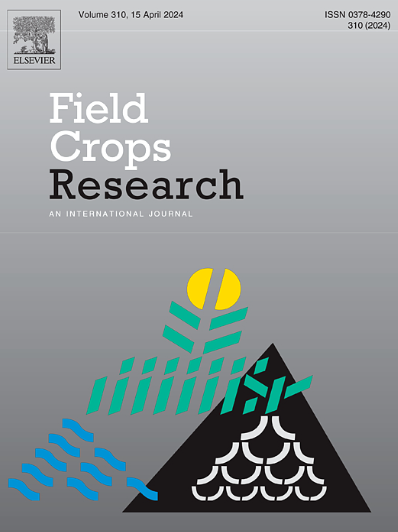Improving soil health and crop productivity through conservation agriculture and nitrogen management in rice-mustard-maize systems
IF 5.6
1区 农林科学
Q1 AGRONOMY
引用次数: 0
Abstract
Context
Conventional crop production practices, including crop establishment using intensive soil tillage, low use of fertilization, low-yielding varieties, and the removal or burning of crop residues, in the Terai region of Nepal have led to low crop yields and nutrient imbalances. Conservation agriculture (CA) offers a potential solution by integrating no-tillage, residue retention, and optimized nitrogen (N) management, yet its impact in this region remains underexplored.
Objectives
This study investigated the effects of CA practices combined with varying N rates on soil physico-chemical properties, nutrient uptake, and crop yields in rice-mustard-maize- systems.
Methodologies
A two-year field experiment (2011–2013) was conducted in farmers’ fields in the Western Terai region using a strip-split plot design. Treatments included: (i) two establishment methods (CA: no-till with residue retention vs. conventional tillage (CT): conventional tillage without residue retention, (ii) two crop varieties (improved or hybrid vs. local), and (iii) four N rates (0, 60, 120, and 180 kg ha−1 for rice and 0, 30, 60, and 90 kg ha−1 for mustard in both years whereas for maize, 0, 60, 120, and 180 kg ha−1 in the first year and 0, 80, 160, and 240 kg ha−1 in the second year). Soil properties, crop yields, and crop nutrient uptake were assessed.
Results and discussion
CA enhanced soil fertility and structure, with significant increase in soil organic carbon (15.4 %) and total nitrogen (14.6 %) at 0–10 cm depth, reduced bulk density, and improved moisture retention. In CA, Nitrogen uptake increased by 3 % in rice and 11 % in maize, while yield increased by 7 % and 9 %, respectively. Hybrid maize and rice outperformed local varieties, yielding 47 % and 3 % higher, respectively. Mustard performed variably, with ‘Bikash’ yielding 44 % more than ‘Goldie’. System productivity increased by 5 % under CA. Optimal yields were achieved with 180 kg ha−1 for rice and maize and 90 kg ha−1 for mustard. Increased N application reduced barrenness and sterility percentage across varieties.
Conclusions
CA combined with optimized N management significantly improves soil health, nutrient dynamics, and crop productivity in intensive rice-based systems. Hybrid varieties exhibit higher productivity under CA than open-pollinated or inbred types. Thus, adopting CA with appropriate N management and variety can sustainably intensify cropping systems, bridging yield gaps while preserving soil health. These findings have implications for broader adoption across Nepal's Terai and similar agroecological zones of Indo-Gangetic Plains, addressing food security and environmental challenges.
通过水稻-芥菜-玉米系统的保护性农业和氮素管理改善土壤健康和作物生产力
尼泊尔Terai地区的传统作物生产做法,包括采用集约化土壤耕作、低施肥、低产品种以及清除或焚烧作物残茬,导致作物产量低和养分不平衡。保护性农业(CA)通过整合免耕、残茬保留和优化氮素管理提供了一个潜在的解决方案,但其在该地区的影响仍未得到充分探讨。目的研究不同施氮量加钙对水稻-芥菜-玉米系统土壤理化性质、养分吸收和作物产量的影响。方法2011-2013年在寺井西部地区农民田间进行了为期两年的田间试验,采用条形分割设计。处理包括:(i)两种建立方法(CA:免耕留渣vs常规耕作(CT):常规耕作不留渣;(ii)两种作物品种(改良或杂交vs本地);(iii)四种施氮量(水稻为0、60、120和180 kg ha - 1,芥菜为0、30、60和90 kg ha - 1,两年玉米为0、60、120和180 kg ha - 1,第二年为0、80、160和240 kg ha - 1)。评估了土壤性质、作物产量和作物养分吸收。结果与讨论ca提高了土壤肥力和结构,在0 ~ 10 cm深度显著增加了土壤有机碳(15.4 %)和全氮(14.6 %),降低了土壤容重,改善了土壤保水能力。在加氮处理下,水稻和玉米的吸氮量分别增加了3 %和11 %,产量分别增加了7 %和9 %。杂交玉米和水稻的表现优于地方品种,产量分别高出47 %和3 %。芥末酱的表现不尽相同,“Bikash”的收益率比“Goldie”高出44% %。在CA处理下,系统生产力提高了5 %。水稻和玉米产量为180 kg ha - 1,芥菜产量为90 kg ha - 1。施氮量的增加降低了品种间的不孕率和不育率。结论在精耕细作的水稻系统中,磷与优化氮素管理相结合可显著改善土壤健康、养分动态和作物生产力。杂交品种在CA下表现出比开放授粉或自交系更高的生产力。因此,在适当的氮素管理和品种的基础上,采用CA可以持续强化种植制度,在保持土壤健康的同时弥合产量差距。这些发现对在尼泊尔的Terai和印度-恒河平原类似的农业生态区更广泛地采用这种方法,解决粮食安全和环境挑战具有重要意义。
本文章由计算机程序翻译,如有差异,请以英文原文为准。
求助全文
约1分钟内获得全文
求助全文
来源期刊

Field Crops Research
农林科学-农艺学
CiteScore
9.60
自引率
12.10%
发文量
307
审稿时长
46 days
期刊介绍:
Field Crops Research is an international journal publishing scientific articles on:
√ experimental and modelling research at field, farm and landscape levels
on temperate and tropical crops and cropping systems,
with a focus on crop ecology and physiology, agronomy, and plant genetics and breeding.
 求助内容:
求助内容: 应助结果提醒方式:
应助结果提醒方式:


